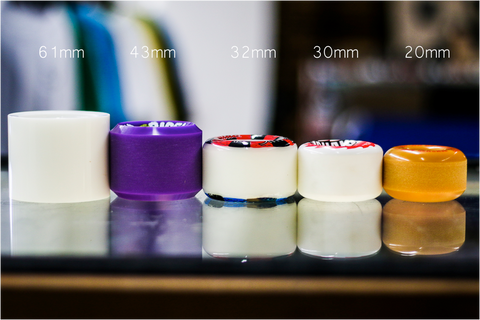How To: Choosing a Freeride Wheel
What Constitutes a “Perfect” Sliding Wheel?- Sam Galus
If you just picked up your first longboard, or have been longboarding for a while and now have the desire to tackle your steeper local hills, then there’s a few things that need to be considered before you purchase your first set of sliding wheels.
YES, every wheel can be slid, but that doesn’t mean every wheel is necessarily easy to slide. When sliding, you’re looking for a wheel that has the perfect ratio between grip, slip, and control.
The first factors to consider are wheel width and height.
Most longboard wheels are around the 70mm diameter, which is a good middle ground for most disciplines of longboarding.
When it comes to sliding, a smaller wheel is easier to kick out. When sliding, your wheels have a side to side bend. Whichever way you are sliding your wheel has force exerted on it in the opposite direction. Therefore the taller your wheel is the greater resistance it has against the pavement, this is why most downhill/race wheels are around 73mm or above. It provides more resistance and quicker deceleration for a downhill wheel. So inversely, you want a smaller (shorter) wheel for sliding because it will have less resistance. However, if you start off with a wheel with a diameter that is too small you will then be sacrificing the overall life of the wheel as well as roll speed. A good middle ground diameter for slide wheels is around 64mm-70mm.

The next thing you need to consider is contact patch.
The contact patch is the portion of the wheel that touches the ground. Your wheel will have more or less grip considering the overall width of the contact patch. The wider your wheel is the more grip it will have, the smaller the contact patch the easier the wheel will slide. You don’t want the wheel that is too narrow or else the roll speed of the wheel will decrease slightly and your wheel may be too slidy. Therefor a good middle ground for wheel width is around 30mm-40mm.

One of the most important things that separates a sliding wheel from a race wheel is the shape of the lip. Typically, downhill wheels will have sharper lips to grip against the pavement and prevent the wheel from sliding out, where sliding wheels will have rounded or beveled lips to allow the wheel to have no hookup point and to prevent from gripping up during a slide. While choosing your wheel, stick to rounded lips to maximize slide ease and to prevent gripping up and highsiding.
The skin of the wheel is most commonly overlooked. Most longboarding wheels come with the skin of the wheel (the shiny part) still intact on the contact patch. This means you will have to break the wheel in before it will slide smoothly. With newer wheel production, wheel companies have started to break the wheel pre-production to cater to those who don’t like the break-in stage of a wheel. What this does is basically reduces break in time as well as makes for an easy slide right out of the package.

These are all variables that will affect the “slideyness” of a slide wheel.
Different wheel companies produce different wheels, meaning the urethane formula in each wheel is going to be completely different between each company. Different urethane formulas are designed for different disciplines. For example, some urethane will have a bit more grip than others/will last a bit longer. Others will slide much more/will not last as long. This can get a bit confusing at times, so us guys at MoBo put together a list of our top 5 most ideal sliding wheels (in no particular order)
- Cadillac - 70mm 81a Swingers/65mm 81a Sugar mamas
- Free Wheel Co. - Platinum Series Wheels
- Remember - Hoots
- Sector 9 - Butter Balls
- Hawgs Wheels – Boss Hawgs
Return to the FAQs section
